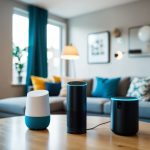Mastering Smart Home Technology for Relaxed Living
In today’s fast-paced world, managing the complexities of daily life can feel overwhelming. Smart home technology offers a gateway to more relaxed living by streamlining everyday tasks and enhancing comfort. By incorporating these intelligent systems, individuals can create an environment that responds to their needs, offering convenience and peace of mind.
The integration of smart devices, like voice-controlled assistants and automated lighting, transforms living spaces into hubs of efficiency and relaxation. Homes equipped with these technologies allow for seamless control over appliances, security, and entertainment, making everyday activities easier and more enjoyable. This not only simplifies routines but also contributes to an overall sense of tranquility in one’s living environment.
Whether it’s adjusting the thermostat from a smartphone or setting mood lighting with a simple voice command, smart home technology provides solutions that are both practical and transformative. As people seek ways to enhance their quality of life, understanding how to effectively utilize these tools becomes increasingly valuable. Readers exploring these themes will find insights and practical advice for maximizing the benefits of smart home innovations.
Foundations of Smart Home Technology
The advancement of smart home technology has revolutionized everyday life by offering streamlined automation and seamless integration. From early systems to the incorporation of IoT, these foundations have set the stage for modern capabilities in centralized control and connectivity.
Evolution of Home Automation Systems
Home automation systems began with simple devices like programmable thermostats and remote-controlled lighting. These early inventions laid the groundwork for more complex systems as technology advanced. As microcontrollers and wireless communication improved, systems became capable of integrating multiple functions, offering users more convenience and efficiency.
In the 1990s, X10 technology emerged, allowing devices to communicate over existing electrical wires. This was a significant step, although it often faced reliability issues. The development of superior protocols like Z-Wave and Zigbee addressed these challenges, enhancing security and reliability. These protocols facilitated the widespread adoption of automation systems that are now integral to smart homes.
Internet of Things (IoT) and Smart Home Integration
The Internet of Things (IoT) has been pivotal in transforming home automation. IoT connects everyday devices to the internet, enabling inter-device communication and remote management. This connectivity empowers users to control their home environment from anywhere using smartphones or computers.
Integration with IoT means devices can work together to enhance the functionality of smart homes. For instance, smart thermostats, security cameras, and lighting can be synchronized to optimize energy use and security. The role of IoT extends to centralized platforms that allow comprehensive control over all connected devices. This seamless integration brings about a level of convenience and efficiency unprecedented in home environments.
Achieving Optimal Efficiency and Comfort
Integrating smart thermostats and smart lighting systems leads to significant energy savings. These technologies not only enhance comfort but also contribute to a more energy-efficient home.
Smart Thermostats and Energy Conservation
Smart thermostats play a crucial role in managing energy consumption effectively. They adapt to the homeowner’s schedule, optimizing heating and cooling with precision. This ensures the home maintains an ideal temperature while minimizing energy usage.
Energy savings increase due to features like learning algorithms and remote control. This allows adjustments from anywhere through a smartphone app, enhancing comfort and efficiency. Some models provide detailed energy reports, helping users identify patterns and implement further energy conservation measures.
By aligning heating and cooling settings with daily routines, smart thermostats reduce unnecessary energy consumption. This not only results in cost savings but also contributes to environmental conservation, making them a wise investment for any household.



